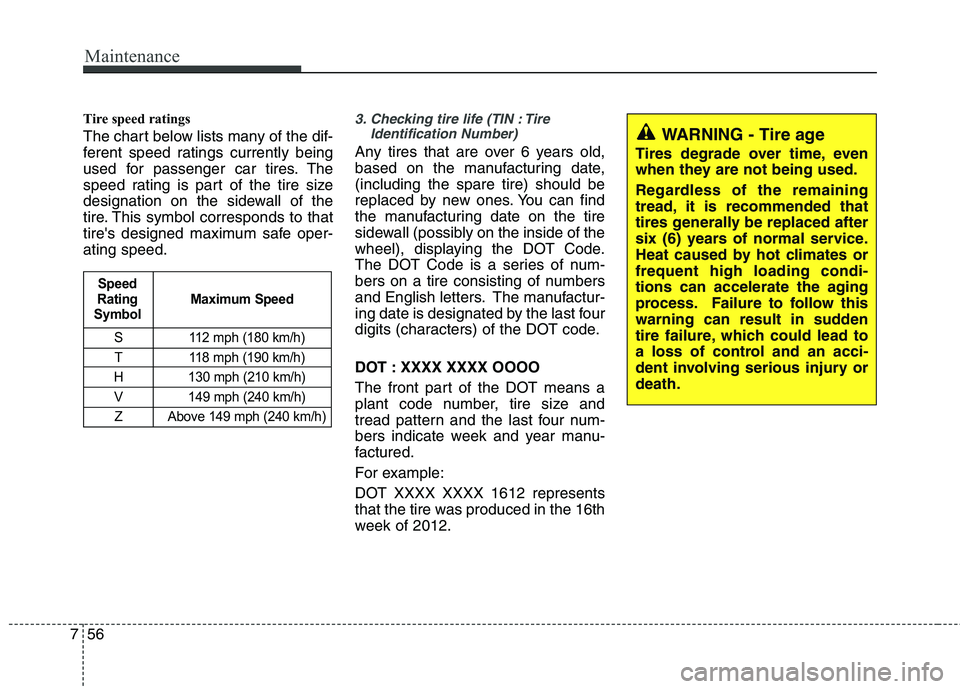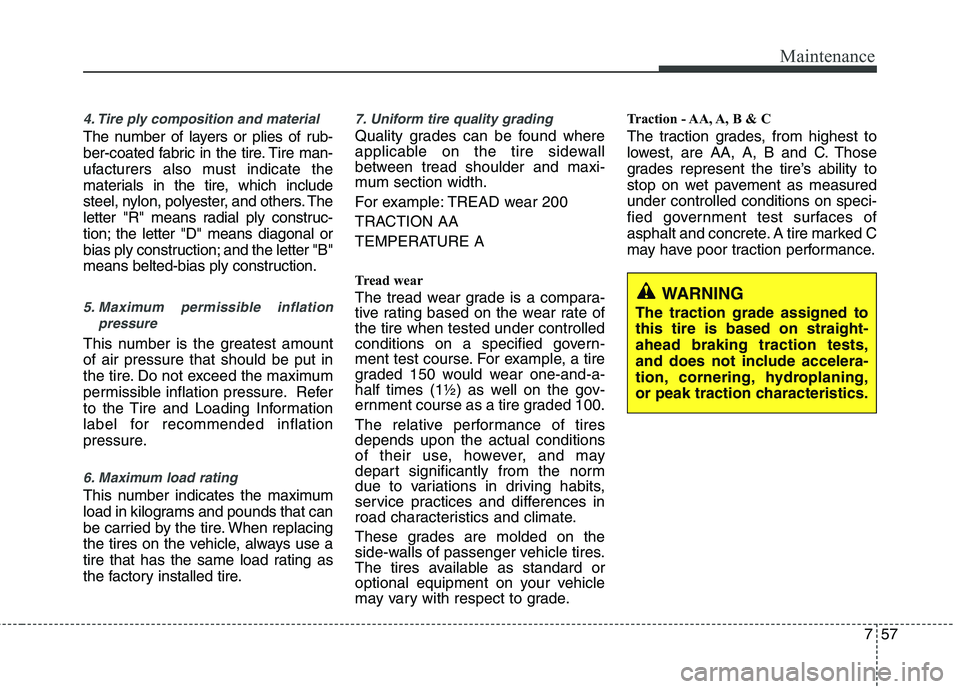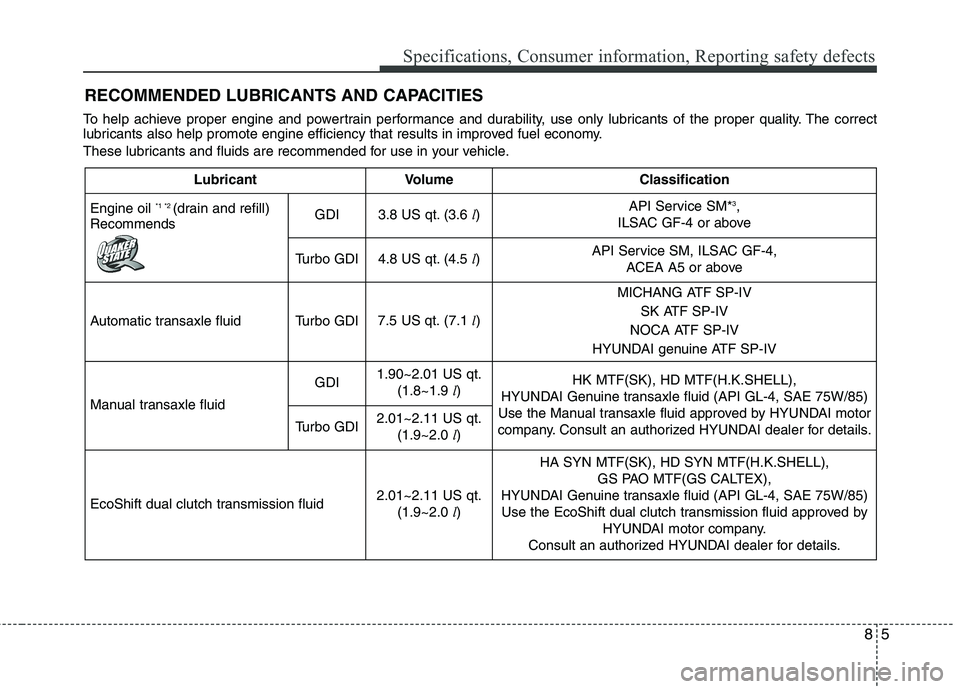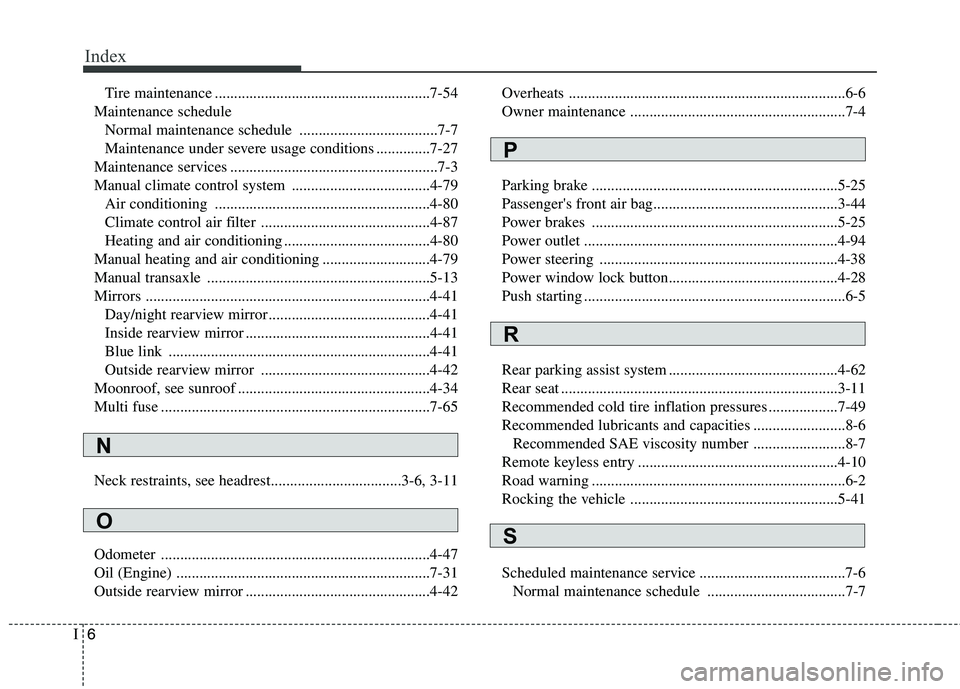2013 HYUNDAI VELOSTER service
[x] Cancel search: servicePage 292 of 372

727
Maintenance
MAINTENANCE UNDER SEVERE USAGE CONDITIONS
SEVERE DRIVING CONDITIONS
A - Repeatedly driving short distance of less than 5 miles (8 km) in normal
temperature or less than 10 miles (16 km) in freezing temperature
B - Extensive engine idling or low speed driving for long distances
C - Driving on rough, dusty, muddy, unpaved, graveled or salt- spread roads
D - Driving in areas using salt or other corrosive materials or in very cold
weather
E - Driving in sandy areasF - Driving in heavy traffic area over 90°F (32°C)
G - Driving on uphill, downhill, or mountain road
H - Towing a Trailer, or using a camper, or roof rack
I - Driving as a patrol car, taxi, other commercial use or vehicle towing
J - Driving over 106 mph (170 km/h)
K - Frequently driving in stop-and-go conditions
The following items must be serviced more frequently on cars normally used under severe driving conditions. Refer to the chart
below for the appropriate maintenance intervals.
R : Replace I : Inspect and, after inspection, clean, adjust, repair or replace if necessary
MAINTENANCE ITEMMAINTENANCE
OPERATIONMAINTENANCE INTERVALSDRIVING CONDITION
ENGINE OIL AND FILTER - GDIREVERY 3,750 MILES (6,000 KM) OR 6 MONTHSA, B, C, D, E, F, G, H, I, J, K
ENGINE OIL AND FILTER - Turbo GDIREVERY 3,000 MILES (5,000 KM) OR 3 MONTHSA, B, C, D, E, F, G, H, I, J, K
AIR CLEANER FILTERRMORE FREQUENTLYC, E
SPARK PLUGSRMORE FREQUENTLYA, B, H, I, K
AUTOMATIC TRANSAXLE FLUIDREVERY 60,000 MILES (96,000 KM) C, E, F, G, H, I, J
MANUAL TRANSAXLE FLUID /
ECOSHIFT DUAL CLUTCH TRANSMISSION FLUIDREVERY 75,000 MILES (120,000 KM) A, C, E, F, G, H, I, J
FRONT BRAKE DISC/PADS, CALIPERSIMORE FREQUENTLYC, D, G, H
REAR BRAKE DISC/PADSIMORE FREQUENTLYC, D, G, F
PARKING BRAKEIMORE FREQUENTLYC, D, G, H
STEERING GEAR BOX, LINKAGE & BOOTS/
LOWER ARM BALL JOINT, UPPER ARM BALL JOINTIMORE FREQUENTLYC, D, E, F, G, H, I
DRIVE SHAFTS AND BOOTSIEVERY 7,500 MILES (12,000 KM) OR 6 MONTHSC, D, E, F, G, H, I
CLIMATE CONTROL AIR FILTER
(FOR EVAPORATOR AND BLOWER UNIT)RMORE FREQUENTLYC, E
Page 311 of 372

Maintenance
46 7
For best battery service
Keep the battery securely mounted.
Keep the battery top clean and dry.
Keep the terminals and connections
clean, tight, and coated with petroleum
jelly or terminal grease.
Rinse any spilled electrolyte from the
battery immediately with a solution of
water and baking soda.
If the vehicle is not going to be used for
an extended time, disconnect the bat-
tery cables.
BATTERY
OFS070015
(Continued)
Wear eye protection when
charging or working near a
battery. Always provide
ventilation when working in
an enclosed space.
An inappropriately dis-
posed battery can be harm-
ful to the environment and
human health. Dispose the
battery according to your
local law(s) or regulation.
When lifting a plastic-cased bat-
tery, excessive pressure on the
case may cause battery acid to
leak, resulting in personal injury.
Lift with a battery carrier or with
your hands on opposite corners.
Never attempt to recharge the
battery when the battery cables
are connected.
The electrical ignition system
works with high voltage. Never
touch these components with the
engine running or the ignition
switched on.
Failure to follow the above warn-
ings can result in serious bodily
injury or death.WARNING- Battery
dangers
Always read the following
instructions carefully when
handling a battery.
Keep lighted cigarettes and
all other flames or sparks
away from the battery.
Hydrogen, a highly com-
bustible gas, is always
present in battery cells and
may explode if ignited.
Keep batteries out of the
reach of children because
batteries contain highly
corrosive SULFURIC ACID.
Do not allow battery acid to
contact your skin, eyes,
clothing or paint finish.
If any electrolyte gets into
your eyes, flush your eyes
with clean water for at least
15 minutes and get immedi-
ate medical attention. If
electrolyte gets on your
skin, thoroughly wash the
contacted area. If you feel a
pain or a burning sensa-
tion, get medical attention
immediately.
(Continued)
Pb
Page 321 of 372

Maintenance
56 7
Tire speed ratings
The chart below lists many of the dif-
ferent speed ratings currently being
used for passenger car tires. The
speed rating is part of the tire size
designation on the sidewall of the
tire. This symbol corresponds to that
tire's designed maximum safe oper-
ating speed.
3. Checking tire life (TIN : Tire
Identification Number)
Any tires that are over 6 years old,
based on the manufacturing date,
(including the spare tire) should be
replaced by new ones. You can find
the manufacturing date on the tire
sidewall (possibly on the inside of the
wheel), displaying the DOT Code.
The DOT Code is a series of num-
bers on a tire consisting of numbers
and English letters. The manufactur-
ing date is designated by the last four
digits (characters) of the DOT code.
DOT : XXXX XXXX OOOO
The front part of the DOT means a
plant code number, tire size and
tread pattern and the last four num-
bers indicate week and year manu-
factured.
For example:
DOT XXXX XXXX 1612 represents
that the tire was produced in the 16th
week of 2012.
S 112 mph (180 km/h)
T 118 mph (190 km/h)
H 130 mph (210 km/h)
V 149 mph (240 km/h)
Z Above 149 mph (240 km/h)
Maximum Speed Speed
Rating
Symbol
WARNING - Tire age
Tires degrade over time, even
when they are not being used.
Regardless of the remaining
tread, it is recommended that
tires generally be replaced after
six (6) years of normal service.
Heat caused by hot climates or
frequent high loading condi-
tions can accelerate the aging
process. Failure to follow this
warning can result in sudden
tire failure, which could lead to
a loss of control and an acci-
dent involving serious injury or
death.
Page 322 of 372

757
Maintenance
4. Tire ply composition and material
The number of layers or plies of rub-
ber-coated fabric in the tire. Tire man-
ufacturers also must indicate the
materials in the tire, which include
steel, nylon, polyester, and others. The
letter "R" means radial ply construc-
tion; the letter "D" means diagonal or
bias ply construction; and the letter "B"
means belted-bias ply construction.
5. Maximum permissible inflation
pressure
This number is the greatest amount
of air pressure that should be put in
the tire. Do not exceed the maximum
permissible inflation pressure. Refer
to the Tire and Loading Information
label for recommended inflation
pressure.
6. Maximum load rating
This number indicates the maximum
load in kilograms and pounds that can
be carried by the tire. When replacing
the tires on the vehicle, always use a
tire that has the same load rating as
the factory installed tire.
7. Uniform tire quality grading
Quality grades can be found where
applicable on the tire sidewall
between tread shoulder and maxi-
mum section width.
For example: TREAD wear 200
TRACTION AA
TEMPERATURE A
Tread wear
The tread wear grade is a compara-
tive rating based on the wear rate of
the tire when tested under controlled
conditions on a specified govern-
ment test course. For example, a tire
graded 150 would wear one-and-a-
half times (1½) as well on the gov-
ernment course as a tire graded 100.
The relative performance of tires
depends upon the actual conditions
of their use, however, and may
depart significantly from the norm
due to variations in driving habits,
service practices and differences in
road characteristics and climate.
These grades are molded on the
side-walls of passenger vehicle tires.
The tires available as standard or
optional equipment on your vehicle
may vary with respect to grade.
Traction - AA, A, B & C
The traction grades, from highest to
lowest, are AA, A, B and C. Those
grades represent the tire’s ability to
stop on wet pavement as measured
under controlled conditions on speci-
fied government test surfaces of
asphalt and concrete. A tire marked C
may have poor traction performance.
WARNING
The traction grade assigned to
this tire is based on straight-
ahead braking traction tests,
and does not include accelera-
tion, cornering, hydroplaning,
or peak traction characteristics.
Page 358 of 372

85
Specifications, Consumer information, Reporting safety defects
RECOMMENDED LUBRICANTS AND CAPACITIES
To help achieve proper engine and powertrain performance and durability, use only lubricants of the proper quality. The correct
lubricants also help promote engine efficiency that results in improved fuel economy.
These lubricants and fluids are recommended for use in your vehicle.
LubricantVolumeClassification
Engine oil *1 *2 (drain and refill)
RecommendsGDI3.8 US qt. (3.6 l)API Service SM*3,
ILSAC GF-4 or above
Turbo GDI4.8 US qt. (4.5 l)API Service SM, ILSAC GF-4,
ACEA A5 or above
Automatic transaxle fluidTurbo GDI7.5 US qt. (7.1 l)
MICHANG ATF SP-IV
SK ATF SP-IV
NOCA ATF SP-IV
HYUNDAI genuine ATF SP-IV
Manual transaxle fluid
GDI1.90~2.01 US qt.
(1.8~1.9 l)HK MTF(SK), HD MTF(H.K.SHELL),
HYUNDAI Genuine transaxle fluid (API GL-4, SAE 75W/85)
Use the Manual transaxle fluid approved by HYUNDAI motor
company. Consult an authorized HYUNDAI dealer for details.
Turbo GDI2.01~2.11 US qt.
(1.9~2.0 l)
EcoShift dual clutch transmission fluid2.01~2.11 US qt.
(1.9~2.0 l)
HA SYN MTF(SK), HD SYN MTF(H.K.SHELL),
GS PAO MTF(GS CALTEX),
HYUNDAI Genuine transaxle fluid (API GL-4, SAE 75W/85)
Use the EcoShift dual clutch transmission fluid approved by
HYUNDAI motor company.
Consult an authorized HYUNDAI dealer for details.
Page 359 of 372

Specifications, Consumer information, Reporting safety defects
6 8
*1Refer to the recommended SAE viscosity numbers on the next page.
*2Engine oils labeled Energy Conserving Oil are now available. Along with other additional benefits, they contribute to fuel econ-
omy by reducing the amount of fuel necessary to overcome engine friction. Often, these improvements are difficult to measure
in everyday driving, but in a year’s time, they can offer significant cost and energy savings.
*
3If the API service SM engine oil is not available in your country, you may substitute API service SL.
LubricantVolumeClassification
Coolant
Automatic transaxle5.5 US qt. (5.2 l)Mixture of antifreeze and water
(Ethylene glycol base coolant for aluminum radiator)Manual Transaxle5.28 US qt. (5.0 l)Ecoshift dual clutch transmission
Brake/clutch fluid0.7~0.8 US qt.
(0.7~0.8 l)FMVSS116 DOT-3 or DOT-4
Fuel13.2 US gal. (50 l)Unleaded gasoline
Page 369 of 372

I5
Index
Engine temperature gauge ..........................................4-46
Tachometer ................................................................4-45
Fuel gauge ..................................................................4-47
Odometer ....................................................................4-47
Trip computer ............................................................4-48
Warning and indicators ..............................................4-50
Instrument panel illumination ......................................4-45
Instrument panel overview ..............................................2-3
Interior care ..................................................................7-84
Interior features ............................................................4-93
Ashtray ......................................................................4-97
Cigarette lighter ..........................................................4-96
Clothes hanger ............................................................4-98
Cup holder ..................................................................4-93
Digital clock ..............................................................4-97
Power outlet................................................................4-94
Sunvisor ......................................................................4-94
Floor mat anchor(s) ....................................................4-98
Interior light ..................................................................4-75
Interior overview ............................................................2-2
Jack and tools ................................................................6-12
Jump starting ..................................................................6-5Key positions ..................................................................5-5
Keys ................................................................................4-2
Label
Air bag warning label ................................................3-57
Tire specification and pressure label ............................8-9
Vehicle certification label ............................................8-8
Lap/shoulder belt ..........................................................3-15
Light bulbs ....................................................................7-72
Lighting ........................................................................4-67
Battery saver function ................................................4-67
Headlight escort function ..........................................4-67
Headlamp dealy ..........................................................4-67
Lubricants and capacities ................................................8-5
Maintenance
Explanation of scheduled maintenance items ............7-28
Maintenance services ..................................................7-3
Maintenance under severe usage conditions ..............7-27
Normal maintenance schedule ....................................7-7
Owner maintenance ......................................................7-4
Scheduled maintenance service....................................7-6
L
J
M
K
Page 370 of 372

Index
6I
Tire maintenance ........................................................7-54
Maintenance schedule
Normal maintenance schedule ....................................7-7
Maintenance under severe usage conditions ..............7-27
Maintenance services ......................................................7-3
Manual climate control system ....................................4-79
Air conditioning ........................................................4-80
Climate control air filter ............................................4-87
Heating and air conditioning ......................................4-80
Manual heating and air conditioning ............................4-79
Manual transaxle ..........................................................5-13
Mirrors ..........................................................................4-41
Day/night rearview mirror ..........................................4-41
Inside rearview mirror ................................................4-41
Blue link ....................................................................4-41
Outside rearview mirror ............................................4-42
Moonroof, see sunroof ..................................................4-34
Multi fuse ......................................................................7-65
Neck restraints, see headrest..................................3-6, 3-11
Odometer ......................................................................4-47
Oil (Engine) ..................................................................7-31
Outside rearview mirror ................................................4-42Overheats ........................................................................6-6
Owner maintenance ........................................................7-4
Parking brake ................................................................5-25
Passenger's front air bag................................................3-44
Power brakes ................................................................5-25
Power outlet ..................................................................4-94
Power steering ..............................................................4-38
Power window lock button............................................4-28
Push starting ....................................................................6-5
Rear parking assist system ............................................4-62
Rear seat ........................................................................3-11
Recommended cold tire inflation pressures ..................7-49
Recommended lubricants and capacities ........................8-6
Recommended SAE viscosity number ........................8-7
Remote keyless entry ....................................................4-10
Road warning ..................................................................6-2
Rocking the vehicle ......................................................5-41
Scheduled maintenance service ......................................7-6
Normal maintenance schedule ....................................7-7
O
P
N
R
S